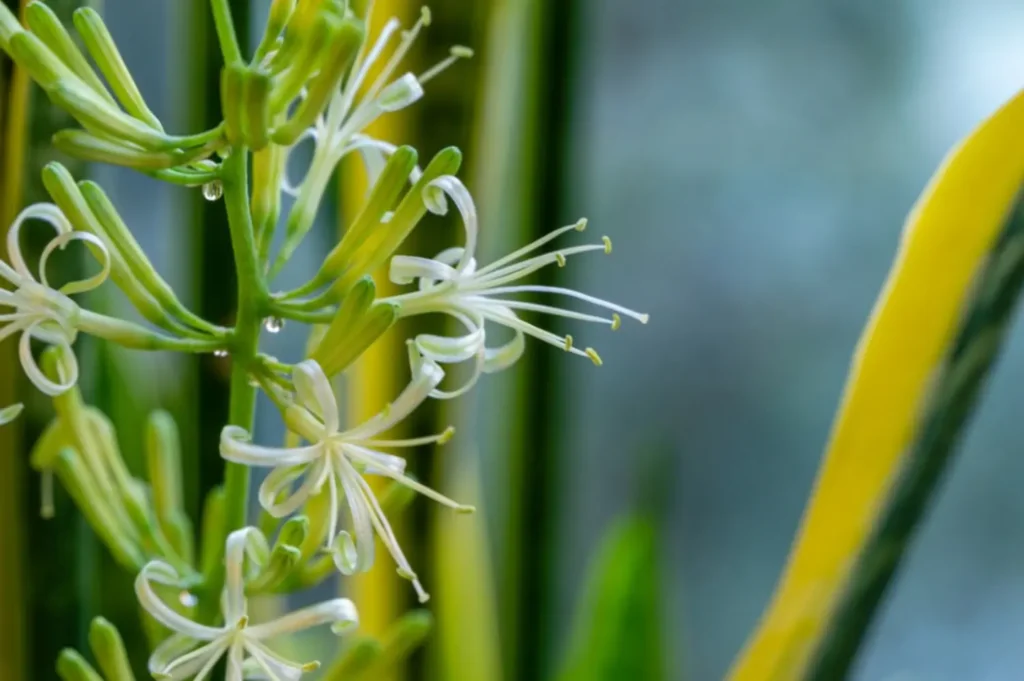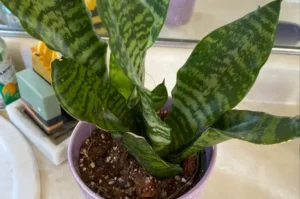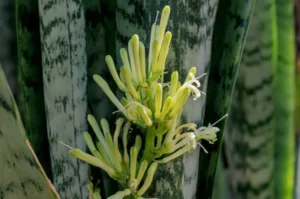If you’ve noticed a tall, slender stalk with clusters of small, fragrant blooms rising from your snake plant, you might be wondering, Why is my snake plant flowering? Snake plants (Sansevieria trifasciata), also known as mother-in-law’s tongue, are popular for their hardiness and air-purifying qualities, but flowering is a rare and special event.
In this article, we’ll explain why your snake plant might be blooming, what it means for your plant’s health, and how you can encourage it to flower again.
What Does a Flowering Snake Plant Look Like?
Before we get into the reasons, let’s briefly describe what snake plant flowers look like for those seeing them for the first time.
Snake plant flowers typically grow on a long, leafless stalk, sometimes up to 3 feet tall. The blooms are:
- Small, tubular, and creamy white or pale green
- Clustered along the stalk in groups
- Often fragrant, releasing a sweet scent, especially in the evening
- Sometimes sticky due to nectar secretion
It’s a striking sight, especially since most people never expect their hardy snake plant to produce flowers indoors.
Why Is My Snake Plant Flowering? Common Reasons
Snake plants don’t bloom frequently, especially when kept indoors. If yours is flowering, consider it a sign of specific growing conditions triggering the event. Here’s why it might be happening:
1. Mild Stress from Being Root-Bound
One of the most common triggers for flowering is when a snake plant becomes root-bound. This means the roots have filled the pot and have little room left to grow. Mild stress like this can encourage the plant to produce flowers as a way to reproduce before conditions worsen.
Signs your snake plant is root-bound:
- Roots growing out of the drainage holes
- Soil drying out quickly
- The pot feels tight and heavy
2. Prolonged, Consistent Care
A snake plant may flower after years of steady, consistent care. When a plant experiences the perfect balance of:
- Indirect bright light. If your home lacks natural light, a compact grow light like this can help mimic ideal conditions for your snake plant.
- Infrequent but deep watering
- Minimal disturbance
- Warm temperatures
It may reward you with a flower spike. This typically happens when the plant feels mature and secure in its environment.
3. Seasonal Changes and Light Exposure
In their natural habitat, snake plants flower during spring or summer when daylight hours increase. This change can trigger blooming if your plant is exposed to longer periods of indirect sunlight, either naturally or under grow lights.
4. Age and Maturity
Most snake plants need to reach a certain age and size before flowering. Typically, it takes several years of healthy growth for a snake plant to be mature enough to bloom. Younger or newly propagated snake plants rarely flower.
5. Genetic Traits
Some varieties of snake plants are naturally more likely to flower than others. For example:
- Sansevieria trifasciata ‘Laurentii’
- Sansevieria ‘Moonshine’
- Sansevieria cylindrical
These cultivars have shown a higher tendency to bloom under the right conditions.
Is It Good or Bad if My Snake Plant Flowers?
It’s actually a positive sign if your snake plant flowers; it means your plant is happy and healthy, or in some cases, reacting to mild stress in a productive way.
However, note that flowering is rare and not essential for a snake plant’s well-being. If your plant never flowers, it can still live for decades and thrive beautifully.
How to Encourage a Snake Plant to Flower
If you’re hoping to see your snake plant bloom again (or for the first time), try these care tips:
- Allow it to become slightly root-bound before repotting
- Place it in bright, indirect light
- Water sparingly, only when the soil is fully dry
- Keep temperatures between 65°F and 85°F (18°C to 29°C)
- Fertilize lightly in the growing season with a balanced houseplant fertilizer
- Avoid moving it frequently, snake plants prefer a stable spot
Is Flowering a Sign of a Healthy Snake Plant?
Many plant owners assume that blooming means their plant is thriving—and in many cases, it does! A flowering snake plant is often a result of favorable conditions like consistent lighting, minimal disturbance, and slightly root-bound pots. These mild stresses mimic the plant’s native environment, encouraging it to reproduce through flowering. However, it’s important to check whether the plant is genuinely healthy overall, as some stress-related blooms may be a survival mechanism.
What Does It Mean Spiritually When a Snake Plant Flowers?
Snake plant flowers are rare and often carry spiritual or symbolic meaning. In many cultures, a blooming snake plant is considered a sign of good luck, prosperity, and positive energy in the home. According to Feng Shui, the flowering is seen as a release of built-up energy—often associated with clearing negativity and boosting harmony indoors. Sharing these insights can attract readers who are interested in both gardening and holistic home environments.
How Often Do Snake Plants Flower?
Snake plants are not frequent bloomers. In fact, most indoor snake plants may only flower once in several years, or sometimes never. The flowering cycle depends on several factors, such as age, pot size, light exposure, and seasonal care routines. Typically, flowering occurs in the spring or early summer when the plant has matured and has experienced mild stress—like becoming root-bound or receiving more sunlight than usual.
What to Do After Your Snake Plant Flowers
After flowering, the bloom spike will eventually wither. Here’s how to care for your plant afterward:
- Trim the flower stalk at the base with sterilized scissors once it dries out
- Wipe away any sticky nectar to prevent attracting pests
- Continue regular care, no need for drastic changes
Remember, flowering doesn’t harm the plant, though it may consume extra energy while the bloom is active.
Should I Prune the Flower After Blooming?
Once the flower stalk fades, it’s safe and recommended to cut it back. Leaving the spent bloom can drain energy from the plant. Use clean shears and trim the flower stalk at its base. While the flowers are beautiful and fragrant, they can take nutrients away from the leaves and roots if left unattended. Pruning also helps keep the plant neat and healthy, encouraging better foliage growth in the long term.
How to Make Snake Plant Flowers Last Longer
To enjoy your blooms as long as possible:
- Keep the plant in stable, indirect light
- Avoid moving it
- Maintain steady room temperatures
- Mist the air around the flower occasionally for humidity. A compact room humidifier can help maintain consistent humidity for longer-lasting blooms.
Fun Fact: Snake Plant Flower Symbolism
In some cultures, a blooming snake plant is seen as a symbol of good luck, protection, and prosperity. Many plant enthusiasts believe it indicates that your home’s environment is balanced and healthy.
Frequently Asked Questions (FAQs)
How often do snake plants flower?
Rarely. Most snake plants flower once in several years, typically when mature and under ideal growing conditions.
Can all snake plant varieties bloom?
Yes, though some cultivars are more prone to flowering than others.
Should I remove the flower stalk after it dies?
Yes, to maintain the plant’s appearance, cut it off at the base with sterile scissors.
Do snake plant flowers have a scent?
Yes! They release a sweet, jasmine-like fragrance, especially noticeable at night.
Is it rare for indoor snake plants to flower?
Yes, it’s uncommon but possible with ideal care or mild stress.
How long do snake plant flowers last?
Typically 2–4 weeks, depending on care and environmental conditions.
Final Thoughts
So why is your snake plant flowering? It’s usually due to a combination of maturity, consistent care, and sometimes mild stress like being root-bound. Either way, it’s a delightful and rare occurrence that signifies your plant is thriving. Whether it blooms again or not, a snake plant remains one of the most resilient, air-purifying, and beginner-friendly houseplants you can own.







4 thoughts on “Why Is My Snake Plant Flowering? 5 Hidden Reasons & What It Means”
Nice to see, very informative
Mine is dead but answered as I left it under direct sunlight for quite some time
Mine is flowering now, at first I thought it was a stowaway squatting in snake plant.
I have several snake plants indoors 2 of which are flowering and have been for several months with no sign of them dying off I am amazed as I usually end up killing plants.